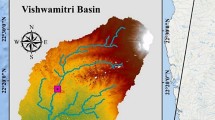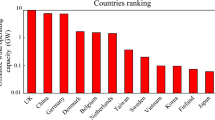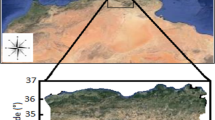Abstract
Changes in patterns of meteorological parameters, like precipitations, temperature, wind, etc., are causing significant increases in various extreme events. And these extreme events, i.e., floods, heatwaves, hurricanes, droughts, etc., lead to a shortage of water resources, crop failures, wildfires, and economic losses. However, Global Circulation Models (GCMs) are considered the most important tools for quantifying climate change. Therefore, we selected 20 different GCMs of precipitation in our research, as the frequency of extreme events, like drought and flood, is highly related to changes in precipitation patterns. However, this research introduced a new weighting scheme — MCFSAWS-Ensemble: Monte Carlo Feature Selection Adaptive Weighting Scheme to Ensemble multiple GCMs, whereas, Monte Carlo Feature Selection (MCFS) is one of the most popular algorithms for discovering important variables. However, the proposed weighting scheme (MCFSAWS-Ensemble) is mainly based on two sources. Initially, it evaluates the prior performance of each GCM model to define their relative importance using MCFS. Then, it computes value by value difference between the observed and simulated model. In addition, the application of this paper is based on the monthly time series data of precipitation in the Tibet Plateau region of China. In addition, we used twenty GCMs from the Coupled Model Intercomparison Project Phase 6 (CMIP6) to analyze the implications of the MCFSAWS-Ensemble. Further, we compared the performance of the MCFSAWS-Ensemble scheme with Simple Model Averaging (SMA) through Mean Average Error (MAE) and correlation statistics. The results of this research indicate that the proposed weighting scheme (MCFSAWS-Ensemble) is more accurate than the SMA approach. Consequently, we recommend the use of advanced machine learning algorithms such as MCFS for making accurate multi-model ensembles.








Similar content being viewed by others
Data availability
The data that support the findings of this study are available from the corresponding author upon reasonable request.
References
Alfonso S, Gesto M, Sadoul B (2021) Temperature increase and its effects on fish stress physiology in the context of global warming. J Fish Biol 98(6):1496–1508
Alhakami W, ALharbi A, Bourouis S, Alroobaea R, Bouguila N (2019) Network anomaly intrusion detection using a nonparametric Bayesian approach and feature selection. IEEE Access 7:52181–52190
Alirezanejad M, Enayatifar R, Motameni H, Nematzadeh H (2020) Heuristic filter feature selection methods for medical datasets. Genomics 112(2):1173–1181
Baldos UL, Hertel TW, Moore FC (2019) Understanding the spatial distribution of welfare impacts of global warming on agriculture and its drivers. Am J Agric Econ 101(5):1455–1472
Çakmak EE, Acar S (2022) The nexus between economic growth, renewable energy and ecological footprint: an empirical evidence from most oil-producing countries. J Clean Prod 352:131548
Çakmak S, Demir T, Canpolat E, Aytaç AS (2021) Evaluation of the effects of precipitation and flow characteristics on suspended sediment transport in mountain-type Mediterranean climate; Korkuteli Stream sample, Antalya, Turkey. Arab J Geosci 14(19):1–17
Chen H, Li X, Wu Y, Zuo L, Lu M, Zhou Y (2022a) Compressive strength prediction of high-strength concrete using long short-term memory and machine learning algorithms. Buildings 12(3):302
Chen R, Duan K, Shang W, Shi P, Meng Y, Zhang Z (2022) Increase in seasonal precipitation over the Tibetan Plateau in the 21st century projected using CMIP6 models. Atmos Res 277:106306
Davies-Barnard T, Zaehle S, Friedlingstein P (2022) Assessment of the impacts of biological nitrogen fixation structural uncertainty in CMIP6 earth system models. Biogeosciences 19(14):3491–3503
Dey A, Sahoo DP, Kumar R, Remesan R (2022) A multimodel ensemble machine learning approach for CMIP6 climate model projections in an Indian River basin. Int J Climatol 42(16):9215–9236
Dong F, Javed A, Saber A, Neumann A, Arnillas CA, Kaltenecker G, Arhonditsis G (2021) A flow-weighted ensemble strategy to assess the impacts of climate change on watershed hydrology. J Hydrol 594:125898
Dou X, Ma X, Zhao C, Li J, Yan Y, Zhu J (2022) Risk assessment of soil erosion in Central Asia under global warming. Catena 212:106056
Dramiński M, Kierczak M, Koronacki J, Komorowski J (2010) Monte Carlo feature selection and interdependency discovery in supervised classification. Advances in Machine Learning II: Dedicated to the Memory of Professor Ryszard S. Michalski 2:371–385
Dramiński M, Rada-Iglesias A, Enroth S, Wadelius C, Koronacki J, Komorowski J (2008) Monte Carlo feature selection for supervised classification. Bioinformatics 24(1):110–117
Duan Q, Duan A (2020) The energy and water cycles under climate change. Natl Sci Rev 7(3):553–557
Ehteram M, Kalantari Z, Ferreira CS, Chau KW, Emami SMK (2022) Prediction of future groundwater levels under representative concentration pathway scenarios using an inclusive multiple model coupled with artificial neural networks. J Water Clim Change 13(10):3620–3643
Hamed MM, Nashwan MS, Shahid S (2022) A novel selection method of CMIP6 GCMs for robust climate projection. Int J Climatol 42(8):4258–4272
Hasan N, Bao Y (2021) Comparing different feature selection algorithms for cardiovascular disease prediction. Health Technol 11:49–62
Jose DM, Vincent AM, Dwarakish GS (2022) Improving multiple model ensemble predictions of daily precipitation and temperature through machine learning techniques. Sci Rep 12(1):1–25
Kim YH, Min SK, Zhang X, Sillmann J, Sandstad M (2020) Evaluation of the CMIP6 multi-model ensemble for climate extreme indices. Weather Clim Extrem 29:100269
Knutti R, Baumberger C, Hadorn GH (2019) Uncertainty quantification using multiple models—prospects and challenges. In: Beisbart C, Saam N (eds) Computer simulation validation. Simulation foundations, methods and applications. Springer. https://doi.org/10.1007/978-3-319-70766-2_34
Lacetera N (2019) Impact of climate change on animal health and welfare. Anim Front 9(1):26–31
Li J, Lu L, Zhang YH, Xu Y, Liu M, Feng K et al (2020) Identification of leukemia stem cell expression signatures through Monte Carlo feature selection strategy and support vector machine. Cancer Gene Ther 27(1):56–69
Li L, Zhu C, Zhang R, Liu B (2021a) Roles of the Tibetan Plateau vortices in the record Meiyu rainfall in 2020. Atmos Sci Lett 22(3):e1017
Li Y, Stroe DI, Cheng Y, Sheng H, Sui X, Teodorescu R (2021b) On the feature selection for battery state of health estimation based on charging–discharging profiles. J Energy Storage 33:102122
Liu F, Xu C, Long Y, Yin G, Wang H (2022) Assessment of CMIP6 model performance for air temperature in the arid region of northwest China and subregions. Atmosphere 13(3):454
Liu H, Wang H, Li N, Shao J, Zhou X, van Groenigen KJ, Thakur MP (2022a) Phenological mismatches between above-and belowground plant responses to climate warming. Nat Clim Change 12(1):97–102
Lovenduski NS, McKinley GA, Fay AR, Lindsay K, Long MC (2016) Partitioning uncertainty in ocean carbon uptake projections: Internal variability, emission scenario, and model structure. Glob Biogeochem Cycles 30(9):1276–1287
Mare F, Bahta YT, Van Niekerk W (2018) The impact of drought on commercial livestock farmers in South Africa. Dev Pract 28(7):884–898
Mokhov II (2022) Climate change: causes, risks, consequences, and problems of adaptation and regulation. Her Russ Acad Sci 92(1):1–11
Morim J, Trenham C, Hemer M, Wang XL, Mori N, Casas-Prat M et al (2020) A global ensemble of ocean wave climate projections from CMIP5-driven models. Sci Data 7(1):105
Mudryk L, Santolaria-Otín M, Krinner G, Ménégoz M, Derksen C, Brutel-Vuilmet C et al (2020) Historical Northern Hemisphere snow cover trends and projected changes in the CMIP6 multi-model ensemble. Cryosphere 14(7):2495–2514
Nematzadeh H, Enayatifar R, Mahmud M, Akbari E (2019) Frequency based feature selection method using whale algorithm. Genomics 111(6):1946–1955
Niaz R, Almanjahie IM, Ali Z, Faisal M, Hussain I (2020) A novel framework for selecting informative meteorological stations using Monte Carlo Feature Selection (MCFS) algorithm. Adv Meteorol 2020:1–13
Niu C, Jian S, Liu S, Liu C, Hu C (2023) Comparative study of reference evapotranspiration estimation models based on machine learning algorithm: a case study of Zhengzhou City. Hydrol Res 54(8):945–964
Oh SG, Sushama L, Teufel B (2020) Arctic precipitation and surface wind speed associated with cyclones in a changing climate. Clim Dyn 55(11):3067–3085
Ombadi M, Nguyen P, Sorooshian S, Hsu KL (2021) Retrospective analysis and Bayesian model averaging of CMIP6 precipitation in the Nile River Basin. J Hydrometeorol 22(1):217–229
Otterbring T, Samuelsson P, Arsenovic J, Elbæk CT, Folwarczny M (2022) Shortsighted sales or long-lasting loyalty? The impact of salesperson-customer proximity on consumer responses and the beauty of bodily boundaries. Eur J Mark 57(7):1854–1885
Perović V, Kadović R, Đurđević V, Pavlović D, Pavlović M, Čakmak D et al (2021) Major drivers of land degradation risk in Western Serbia: current trends and future scenarios. Ecol Indic 123:107377
Raftery AE, Gneiting T, Balabdaoui F, Polakowski M (2005) Using Bayesian model averaging to calibrate forecast ensembles. Mon Weather Rev 133(5):1155–1174
Rajak J (2021) A preliminary review on impact of climate change and our environment with reference to global warming. Int J Environ Sci 10:11–14
Raju KS, Kumar DN (2020) Review of approaches for selection and ensembling of GCMs. J Water Clim Change 11(3):577–599
Rungskunroch P, Shen ZJ, Kaewunruen S (2022) Benchmarking socio-economic impacts of high-speed rail networks using K-nearest neighbour and Pearson’s correlation coefficient techniques through computational model-based analysis. Appl Sci 12(3):1520
Russo MA, Carvalho D, Martins N, Monteiro A (2022) Forecasting the inevitable: a review on the impacts of climate change on renewable energy resources. Sustain Energy Technol Assess 52:102283
Sanderson BM, Knutti R, Caldwell P (2015) Addressing interdependency in a multimodel ensemble by interpolation of model properties. J Clim 28(13):5150–5170
Scafetta N (2022) CMIP6 GCM ensemble members versus global surface temperatures. Clim Dyn 1-30:3091–3120. https://doi.org/10.1007/s00382-022-06493-w
Seifi A, Ehteram M, Soroush F, Haghighi AT (2022) Multi-model ensemble prediction of pan evaporation based on the Copula Bayesian Model Averaging approach. Engineering Applications of Artificial Intelligence 114:105124
Smith DM, Scaife AA, Hawkins E, Bilbao R, Boer GJ, Caian M et al (2018) Predicted chance that global warming will temporarily exceed 1.5 C. Geophys Res Lett 45(21):11–895
Sperry JS, Venturas MD, Todd HN, Trugman AT, Anderegg WR, Wang Y, Tai X (2019) The impact of rising CO2 and acclimation on the response of US forests to global warming. Proc Natl Acad Sci 116(51):25734–25744
Tadist K, Najah S, Nikolov NS, Mrabti F, Zahi A (2019) Feature selection methods and genomic big data: a systematic review. J Big Data 6(1):1–24
Try S, Tanaka S, Tanaka K, Sayama T, Khujanazarov T, Oeurng C (2022) Comparison of CMIP5 and CMIP6 GCM performance for flood projections in the Mekong River Basin. J Hydrol Reg Stud 40:101035
Varney RM, Chadburn SE, Burke EJ, Cox PM (2022) Evaluation of soil carbon simulation in CMIP6 Earth system models. Biogeosciences 19(19):4671–4704
Wang W, Zhang P, Garzione CN, Liu C, Zhang Z, Pang J et al (2022) Pulsed rise and growth of the Tibetan Plateau to its northern margin since ca. 30 Ma. Proc Natl Acad Sci 119(8):e2120364119
Wang Z, Afgan MS, Gu W, Song Y, Wang Y, Hou Z et al (2021) Recent advances in laser-induced breakdown spectroscopy quantification: from fundamental understanding to data processing. TrAC Trends Analyt Chem 143:116385
Wei Q, Xu J, Liao L, Yu Y, Liu W, Zhou J, Ding Y (2021) Indicators for evaluating trends of air humidification in arid regions under circumstance of climate change: relative humidity (RH) vs. Actual water vapour pressure (ea). Ecol Ind 121:107043
Wine ML, Davison JH (2019) Untangling global change impacts on hydrological processes: resisting climatization. Hydrol Process 33(15):2148–2155
Wootten AM, Massoud EC, Sengupta A, Waliser DE, Lee H (2020) The effect of statistical downscaling on the weighting of multi-model ensembles of precipitation. Climate 8(12):138
Wu J, Shi Y, Xu Y (2020) Evaluation and projection of surface wind speed over China based on CMIP6 GCMs. J Geophys Res Atmos 125(22):e2020JD033611
Xu D, Ivanov VY, Kim J, Fatichi S (2019) On the use of observations in assessment of multi-model climate ensemble. Stoch Environ Res Risk Assess 33(11-12):1923–1937
Xu J, Zhang X, Zhang W, Hou N, Feng C, Yang S et al (2022a) Assessment of surface downward longwave radiation in CMIP6 with comparison to observations and CMIP5. Atmos Res 270:106056
Xu Y, Zhang H, Yang F, Tong L, Yan D, Yang Y et al (2022b) State of charge estimation of supercapacitors based on multi-innovation unscented Kalman filter under a wide temperature range. Int J Energy Res 46(12):16716–16735
Yan C, Liang J, Zhao M, Zhang X, Zhang T, Li H (2019) A novel hybrid feature selection strategy in quantitative analysis of laser-induced breakdown spectroscopy. Anal Chim Acta 1080:35–42
Yasmin N, Jamuda M, Panda AK, Samal K, Nayak JK (2022) Emission of greenhouse gases (GHGs) during composting and vermicomposting: measurement, mitigation, and perspectives. Energy Nexus 7:100092
Yue Y, Yan D, Yue Q, Ji G, Wang Z (2021) Future changes in precipitation and temperature over the Yangtze River Basin in China based on CMIP6 GCMs. Atmos Res 264:105828
Zeng W, Jin S, Liu W, Qian C, Luo P, Ouyang W, Wang X (2022) Not all tokens are equal: human-centric visual analysis via token clustering transformer. In: Proceedings of the IEEE/CVF Conference on Computer Vision and Pattern Recognition, pp 11101–11111
Zhang X, Hua L, Jiang D (2022) Assessment of CMIP6 model performance for temperature and precipitation in Xinjiang, China. Atmos Ocean Sci Lett 15(2):100128
Zhang X, Xiong Z, Zhang X, Shi Y, Liu J, Shao Q, Yan X (2016) Using multi-model ensembles to improve the simulated effects of land use/cover change on temperature: a case study over northeast China. Clim Dyn 46:765–778
Zhang Y, Yang X, Chen C (2021) Substantial decrease in concurrent meteorological droughts and consecutive cold events in Huai River Basin, China. Int J Climatol 41(13):6065–6083
Zheng Z, Zhao L, Oleson KW (2021) Large model structural uncertainty in global projections of urban heat waves. Nat Commun 12(1):3736
Zhou H, Wang X, Zhu R (2022) Feature selection based on mutual information with trend and uncertainty. Clim Dyn 1-21. https://doi.org/10.1007/s00382-022-06518-4
Funding
The current research is a part of a funded research project awarded by the University of the Punjab Lahore, Pakistan (2022). Therefore, the authors are thankful to the project awarding institution.
Author information
Authors and Affiliations
Contributions
Abdul Baseer and Zulfiqar Ali conceived the presented idea. Abdul Baseer developed the theory and performed the computations. Maryam Ilyas verified the analytical methods and computations. Mahrukh Yousaf revised the manuscript and addressed all the technical questions raised by the reviewers. All authors discussed the results and contributed to the final manuscript.
Corresponding author
Ethics declarations
Competing interests
The authors declare no competing interests.
Additional information
Publisher’s Note
Springer Nature remains neutral with regard to jurisdictional claims in published maps and institutional affiliations.
Rights and permissions
Springer Nature or its licensor (e.g. a society or other partner) holds exclusive rights to this article under a publishing agreement with the author(s) or other rightsholder(s); author self-archiving of the accepted manuscript version of this article is solely governed by the terms of such publishing agreement and applicable law.
About this article
Cite this article
Baseer, A., Ali, Z., Ilyas, M. et al. A new Monte Carlo Feature Selection (MCFS) algorithm-based weighting scheme for multi-model ensemble of precipitation. Theor Appl Climatol 155, 513–524 (2024). https://doi.org/10.1007/s00704-023-04648-1
Received:
Accepted:
Published:
Issue Date:
DOI: https://doi.org/10.1007/s00704-023-04648-1




